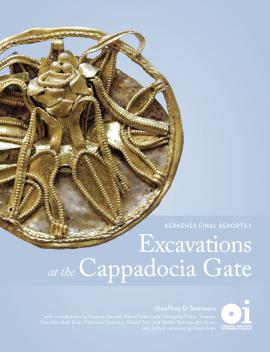The Oriental Institute of the University of Chicago announces a new publication in print and online:
Excavations at the Cappadocia Gate: Kerkenes Final Reports 1
By Geoffrey D. Summers, with contributions by Susanne Berndt, Yilmaz Selim Erdal, Evangelia Piskin, Yasemin Özarslan, Noël Siver, Francoise Summers, Robert Tate, and Nilüfer Baturayoğlu Yöney, introduction by David Stronach, and Turkish summary by Güzin Eren
Oriental Institute Publications 145
Chicago: The Oriental Institute, 2021
ISBN (hardcover): 978-1-61491-059-6
ISBN (eBook): 978-1-61491-060-2
Pp. 408 (L + 358)
3 figures; 185 plates; 12 tables
Hardcover, 9 x 11.75 in; $149
DOWNLOAD: https://oi.uchicago.edu/research/publications/oip/oip-145-excavations-cappadocia-gate
PURCHASE: www.isdistribution.com/Refer.aspx?isbn=9781614910596
The city on the Kerkenes Dağ in the high plateau of central Turkey was a new Iron Age capital, very probably Pteria. Founded in the later seventh century BC, the city was put to the torch in the mid-sixth century and then abandoned. Between 1999 and 2011, what we have called the Cappadocia Gate—one of the seven city gates that pierce the 7 km of strong stone defenses—was excavated in its entirety. This volume documents as fully as possible the results of those excavations. The location of the gate and its architecture are discussed and illustrated, with a chapter devoted to its partial restoration. Cultic installations within the gate structure include a built stepped monument with semi-iconic idol, an aniconic stela, and graffiti representing similar stones. Sculpture set up at the back of the gate comprised many fragments of a life-size statue supported by a plinth bearing adorsed sphinxes carved in relief. The remains of two human victims of the destruction are examined, as are animal bones that perhaps provide evidence of meals consumed by builders of the gate. Pottery and other finds, including well-preserved iron door bands, are presented, as is an exceptional ornament of gold and electrum. A final chapter attempts to place these remarkable discoveries in a wider context.
The gate plan and the cultic installations and sculpture set up inside the gate appear to be entirely Phrygian. Combined with evidence of Paleo-Phrygian inscription and graffiti already published (OIP 135), this volume sheds dramatic and unexpected new evidence for the power, wealth, and sophistication of an eastward expansion of Phrygia. The brief existence, hardly more than one hundred years, together with the excellent stratigraphic context of the destruction level, provide an unparalleled window onto the first half of the sixth century BC on the Anatolian Plateau.
TABLE OF CONTENTS
Acknowledgments
Introduction. David Stronach
1. Background: Excavation Strategies, Methods, and Notation. Geoffrey D. Summers and Françoise Summers
2. GIS Analysis of the Cappadocia Gate Location. Yasemin Özarslan and Geoffrey D. Summers
3. Excavation of the Cappadocia Gate. Geoffrey D. Summers and Françoise Summers
4. Cappadocia Gate: Architectural Documentation, Conservation, and Environmental Control. Nilüfer Baturayoğlu Yöney
5. Sculpture, Idol, and Stelae. Geoffrey D. Summers, with contributions by Noël Siver
6. Blocks with Graffiti. Susanne Berndt
7. Human Skeletal Remains from the Iron Age Destruction at the Cappadocia Gate. Yılmaz Selim Erdal
8. The Finds. Geoffrey D. Summers
9. The Iron Age Pottery. Geoffrey D. Summers
10. Animal Bones from Iron Age Levels. Evangelia Pişkin
11. Early Byzantine Period Remains. Robert Tate and Geoffrey D. Summers
12. Interpretations. Geoffrey D. Summers
13. Türkçe Özet / Turkish Summary. Güzin Eren
Appendix 1. Concordance of Site Inventory and Identification Numbers
Appendix 2. Concordance of Identification Numbers ordered by Trench, then by Unit
Appendix 3. Concordance of Trenches
Appendix 4. Lists of Units of Excavation by Trench
Appendix 5. Place Names
Appendix 6. Technical Abbreviations
Plates


